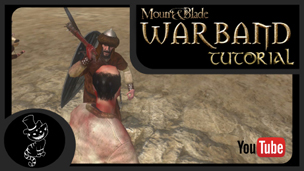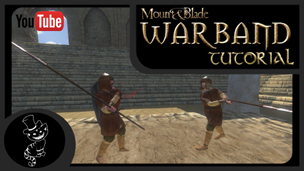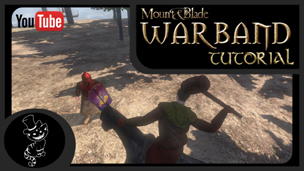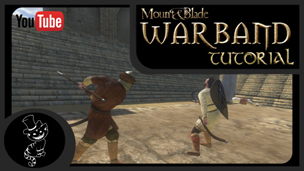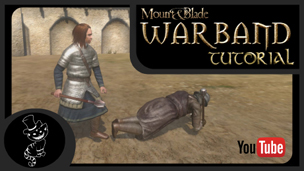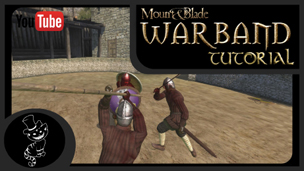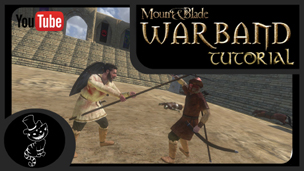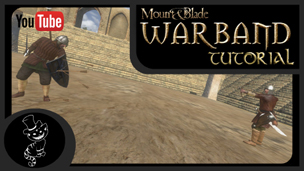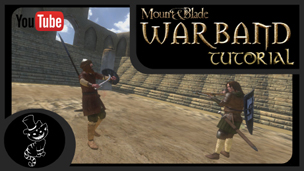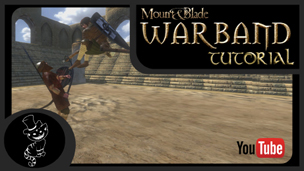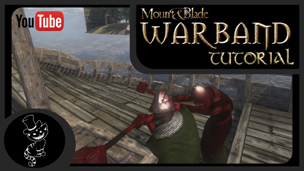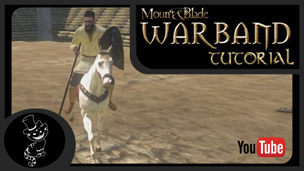Some time ago my friend RawnRawn had the idea to make a warband guide, which mainly focuses on the mechanics behind the game.
It was finished at the end of december 2015 and was published as a steamguide right after. http://steamcommunity.com/sharedfiles/filedetails/?id=580035086
As everyone doesn't use steam, we as CCC decided to also publish the guide here. It includes information which many of you people might not be aware of.
The formatting is kept close to original and all the text is original, written by RawnRawn. Personal thanks to Chatnoir for the help with formatting.
As TW forums only let you post 3 embedded youtube videos per topic, we changed it so that you need to click the images to get on the actual youtube site.
Enjoy the guide.

0. Natural Movement
1. Momentum and Attack Charging
2. Attack Reach
3. Armour
4. Damage Types
5. Special Weapon Attributes
6. Getting Hit
7. Stunning
8. Bypassing Shields with Projectiles
9. Chambers
General tips and tricks
End and credits
[anchor=tag1]0. Natural Movement
Let's start by looking around! I know it may sound silly but what you will notice is your character turning faster the faster you move your mouse, then when you try turning 180 degrees in a quarter of a second your character take a brief moment to catch up. Have you tried turning your whole body 180 degrees in a combat ready stance in a quarter of a second in real life? Unless you're an insect I reckon you'll fail, so Warband has what I'd call a natural body turning speed, you cannot turn quite as fast as you can move your mouse. If you're trying to bait someone into attacking you in the back but surprise those in the last second by turning around and pulling some mischief you'll need to take the time to actually turn around. Because of this you are able to pull some mighty mean manoeuvres, if you ever find yourself behind your opponent try sticking to their back and move with them while stabbing them in the butt.
You have a free look button you can utilize to look around you without letting anyone else know you can see them as you have their backs against them, also useful for peeking around corners and viewing your outfit. There is a button which enables you to zoom a fair distance and when using ranged weapons the crosshair expand to give you an indication of the accuracy falloff. Lastly you can control the distance of the camera behind your character. Further away for superior peripheral vision or closer for a more focused view. The last function is hidden and does not show up in the controls but the buttons are - for zooming out and + for zooming in.
[anchor=tag2]1. Momentum and Attack Charging
Mount and Blade games are the first (to my knowledge) to implement a real world momentum system in combat which is one of the main things which makes the melee combat in this game unique.
If you try punching someone in the face when they are in front of you while running backwards you’re gonna have a hard time doing any significant damage to them.
In Warband you can kill your opponent with one strike or it may take you 10 with the same weapon. What factors into your attack are the initial damage values your weapon has (the number you see when selecting the weapon in the equipment screen), the direction and speed of your movement which increases or reduces your swing speed as well as the way you turn your upper body using your mouse when swinging. You have three hitboxes you can connect with on your opponent that will do different damage depending on where you hit and armour that applies to those specific locations, I will go more in depth in the armour section.
For ranged weapons your damage depends on the distance you have between you and your opponent as well as what direction they are moving and how fast, if an opponent is riding towards you at the fastest pace you’ll deal a lot of damage to horse and rider but when the horse has sped past you and is heading away you can throw a javelin in the back of their helmetless head and they may survive it. Projectiles speed factors into it as well, out of the ranged weapons the throwing axes have the slowest projectile speed so the damage output would suffer more if your opponent is going away from you.
Attack charging: Depending on how long you hold your attack before releasing it you have the potential to do more damage than releasing it as soon as it’s ready. (by just tapping the left mouse button) If you hold it for a second or two (depending on the weapon speed) you’ll do the maximum potential damage for the weapon as well as increasing the stunning and block crushing ability of the weapon if it’s wielded in both hands in an overhead swing (more on that in the stunning and special weapon attributes sections). Holding the weapon’s attack for an eternity before releasing it will allow you a damage boost beyond releasing immediately but not as great as holding it for a brief moment.
[anchor=tag3]2. Attack Reach
Weapon range factors into your damage, say if you hit with a short sword you'll always hit with the effective part of the weapon, but if it's a long weapon and you hit at close range the damage will be reduced. To put it into perspective a 3 meter long weapon would not be as effective at 1 meter range as a 2 meter long weapon would even though the rest of the stats would be the same. You may think that attacking with a 1 meter weapon would yield the best result but no, as you connect with the very end of your weapon it would just scratch your opponent, to transmit the largest part of kinetic energy into your opponent at 1 meter range I suggest a 150 cm long weapon.
Finally when fighting indoors you gotta make sure you’ve got room to swing your weapon, you cannot swing through stone walls strangely enough, thrusting or using overheads against your opponent in a narrow portion of a Swadian castle would be more sensible than trying to swing left and right, those stone walls won’t budge.
[anchor=tag4]3. Armour
It protects you, not too hard to work out but it saves lives and it’s worth encumbering yourself with it. The body armour you’ll see players with a bit of brain in their heads wearing protects them with 18 to 26 at the start of a map. Cavalry and archers tend to have lighter armour for cavalry need to spend denars on their horse and archers tend to spend it on their bows and arrows. Armour is separated into three zones: Head, body and legs. Hand armour gives bonus protection to your body and body armours can give additional protection to your legs. Your head armour is only dependant on your head wear though, and considering that’s the critical spot I heavily suggest getting a helmet made of metal, no I do not care if you want to be a main protagonist in an action film, people without helmets died in historical battles.
As cavalry it is a good idea to spend more money on leg armour, infantry hitting your horse will most likely also hit you in the legs with swings. Because of your higher posture you will rarely get hit in the head so helmets are less important to you. As an infantry you want to have a good amount of head armour, skilled infantry will aim for the head with their melee attacks and with a really good helmet you may even survive a headshot by an archer.
To overcome armour you can trust in Mother Fortuna or make your own fortune using piercing and blunt weapons. The armour in Warband is random, it protects you with 50-100% meaning that hitting them with a blade over and over again in the same angle with the same momentum will produce different results. It is the only factor which is random when it comes to the damage that is dealt and personally I do not wish to see Taleworlds repeat the same mechanic in Warband II.
[anchor=tag5]4. Damage Types
There are three of them, cutting, piercing and blunt(ing?). They have different properties, let’s start with the cutting one which is applied to bladed weapons with a cutting edge such as swords, axes, sabres and cleavers. Cutting damage is the worst at ignoring armour but the best at shattering shields, axes deal additional damage to shields along with their high cutting damage. Cutting damage cannot be made by thrusts.
Piercing damage is applied to all ranged weapons (except for throwing axes) and ignores armour by 65%. It is the worst damage type for shattering shields but high piercing ranged weapons can penetrate shields at certain ranges and hit the one holding a shield with a reduced impact than a hit without needing to penetrate the shield first (more on that later). Piercing damage is done mainly by thrusting with melee weapons but there are a few swinging piercing weapons such as sickles, spiked clubs and the Morningstar.
Blunt weapons ignores armour by 50%, in addition to that they have a random chance of knocking your opponent down if their base damage exceeds 20. In single player blunt weapons are guaranteed to knock your opponent unconscious rather than killing them allowing for capture.
blunt weapons are maces, hammers, fists and horse hooves trampling you over.
[anchor=tag6]5. Special Weapon Attributes
One handed, two handed, polearm and throwing axes are given the “bonus to shield” attribute which allow them to shatter shields using fewer hits. The resistance stat of a shield, its health and the shield skill of the user will determine how much damage a shield can withstand before breaking.
Some heavier two handed and polearm hafted weapons have a negative “unbalanced” attribute which means they have an increased recovery time than other weapons when attacking. A weapon with the same speed but without the unbalanced attribute would be quicker at consecutively attacking than the weapon with the unbalanced attribute.
[anchor=tag7]6. Getting Hit
Unless you’re me on a Saturday night pumped up by tea and cookies you’ll eventually get hit on the battlefield. Depending on the type of weapon you get hit by and mother fortuna you’re staggered in different ways.
Regular: Whatever action your character was doing is interrupted but you’re free to use your lower body, one handed cutting weapons will most likely have this impact on you.
Immobilize: Unable to use neither lower nor upper body for anything in a moment. This is attributed to all polearms (with a few exceptions) but not two handed weapons, heavy ranged weaponry have this effect as well.
Destabilize: This is a hit with so much force that it causes your character to stumble. In this moment you’re unable to move, attack nor block until you’ve regained your balance. If you’re hit in the back you will stumble forward, hits from the side will cause you to stumble sideways. If you’re destabilized in melee you could be hit again by the same opponent if the weapon they are using is quick enough. This is caused by kicks, attacks by polearms and ranged projectiles, cannot be caused by one handed, two handed weapons nor horse hooves. A popular combo is the so called kick slash which requires you to follow up with an attack after kicking your opponent (default key: E), for this to be successful you need to release your attack as soon as both your feet are on the ground, doing it sooner will cause your attack to cancel, doing it too late will allow your opponent to block it.
[anchor=tag8]7. Stunning
This is a mechanic which even veterans may not be aware off. Stunning in this case is the act of disabling your opponents defence. It functions differently depending on if it’s manual blocking or blocking done with a shield.
How it works is that whenever you’re using a weapon in two hands your overhead attacks has the ability to stun your opponents guard. When stunned your opponent has got a moment where he/she is unable to attack and they are unable to block another attack.
[anchor=tag9]8. Bypassing Shields with Projectiles
This section is dedicated to the boys and girls with the bows, crossbows and throwing weapons hailing from first person shooter games where those obnoxious shields are not present.
[anchor=tag10]9. Chambers
Now for the cool stuff, I’m gonna teach you how to be a badass and block attacks without touching the right mouse button!
[anchor=tag11]General tips and tricks
This is not really a section on its own as it does not relate to anything in particular but these tricks could prove useful in some situations.
[anchor=tag12]End and credits
There you go, now you're ready to go out and take on the world! Oh and one last thing:
It was finished at the end of december 2015 and was published as a steamguide right after. http://steamcommunity.com/sharedfiles/filedetails/?id=580035086
As everyone doesn't use steam, we as CCC decided to also publish the guide here. It includes information which many of you people might not be aware of.
The formatting is kept close to original and all the text is original, written by RawnRawn. Personal thanks to Chatnoir for the help with formatting.
As TW forums only let you post 3 embedded youtube videos per topic, we changed it so that you need to click the images to get on the actual youtube site.
Enjoy the guide.

This guide is aimed at rookies and veterans, mainly focusing on the melee combat of the game but there are some information useful to archers and cavalry as well.
So you’re ready to dive head first into the cold and unforgiving land of Calradia? Worse yet you may be considering to take your skills to multiplayer?
Fear not for this guide will teach you everything you need to know about combat that the tutorial does not.
So you’re ready to dive head first into the cold and unforgiving land of Calradia? Worse yet you may be considering to take your skills to multiplayer?
Fear not for this guide will teach you everything you need to know about combat that the tutorial does not.
0. Natural Movement
1. Momentum and Attack Charging
2. Attack Reach
3. Armour
4. Damage Types
5. Special Weapon Attributes
6. Getting Hit
7. Stunning
8. Bypassing Shields with Projectiles
9. Chambers
General tips and tricks
End and credits
[anchor=tag1]0. Natural Movement
Let's start by looking around! I know it may sound silly but what you will notice is your character turning faster the faster you move your mouse, then when you try turning 180 degrees in a quarter of a second your character take a brief moment to catch up. Have you tried turning your whole body 180 degrees in a combat ready stance in a quarter of a second in real life? Unless you're an insect I reckon you'll fail, so Warband has what I'd call a natural body turning speed, you cannot turn quite as fast as you can move your mouse. If you're trying to bait someone into attacking you in the back but surprise those in the last second by turning around and pulling some mischief you'll need to take the time to actually turn around. Because of this you are able to pull some mighty mean manoeuvres, if you ever find yourself behind your opponent try sticking to their back and move with them while stabbing them in the butt.
You have a free look button you can utilize to look around you without letting anyone else know you can see them as you have their backs against them, also useful for peeking around corners and viewing your outfit. There is a button which enables you to zoom a fair distance and when using ranged weapons the crosshair expand to give you an indication of the accuracy falloff. Lastly you can control the distance of the camera behind your character. Further away for superior peripheral vision or closer for a more focused view. The last function is hidden and does not show up in the controls but the buttons are - for zooming out and + for zooming in.
[anchor=tag2]1. Momentum and Attack Charging
Mount and Blade games are the first (to my knowledge) to implement a real world momentum system in combat which is one of the main things which makes the melee combat in this game unique.
If you try punching someone in the face when they are in front of you while running backwards you’re gonna have a hard time doing any significant damage to them.
In Warband you can kill your opponent with one strike or it may take you 10 with the same weapon. What factors into your attack are the initial damage values your weapon has (the number you see when selecting the weapon in the equipment screen), the direction and speed of your movement which increases or reduces your swing speed as well as the way you turn your upper body using your mouse when swinging. You have three hitboxes you can connect with on your opponent that will do different damage depending on where you hit and armour that applies to those specific locations, I will go more in depth in the armour section.
For ranged weapons your damage depends on the distance you have between you and your opponent as well as what direction they are moving and how fast, if an opponent is riding towards you at the fastest pace you’ll deal a lot of damage to horse and rider but when the horse has sped past you and is heading away you can throw a javelin in the back of their helmetless head and they may survive it. Projectiles speed factors into it as well, out of the ranged weapons the throwing axes have the slowest projectile speed so the damage output would suffer more if your opponent is going away from you.
Attack charging: Depending on how long you hold your attack before releasing it you have the potential to do more damage than releasing it as soon as it’s ready. (by just tapping the left mouse button) If you hold it for a second or two (depending on the weapon speed) you’ll do the maximum potential damage for the weapon as well as increasing the stunning and block crushing ability of the weapon if it’s wielded in both hands in an overhead swing (more on that in the stunning and special weapon attributes sections). Holding the weapon’s attack for an eternity before releasing it will allow you a damage boost beyond releasing immediately but not as great as holding it for a brief moment.
[anchor=tag3]2. Attack Reach
Weapon range factors into your damage, say if you hit with a short sword you'll always hit with the effective part of the weapon, but if it's a long weapon and you hit at close range the damage will be reduced. To put it into perspective a 3 meter long weapon would not be as effective at 1 meter range as a 2 meter long weapon would even though the rest of the stats would be the same. You may think that attacking with a 1 meter weapon would yield the best result but no, as you connect with the very end of your weapon it would just scratch your opponent, to transmit the largest part of kinetic energy into your opponent at 1 meter range I suggest a 150 cm long weapon.
Finally when fighting indoors you gotta make sure you’ve got room to swing your weapon, you cannot swing through stone walls strangely enough, thrusting or using overheads against your opponent in a narrow portion of a Swadian castle would be more sensible than trying to swing left and right, those stone walls won’t budge.
[anchor=tag4]3. Armour
It protects you, not too hard to work out but it saves lives and it’s worth encumbering yourself with it. The body armour you’ll see players with a bit of brain in their heads wearing protects them with 18 to 26 at the start of a map. Cavalry and archers tend to have lighter armour for cavalry need to spend denars on their horse and archers tend to spend it on their bows and arrows. Armour is separated into three zones: Head, body and legs. Hand armour gives bonus protection to your body and body armours can give additional protection to your legs. Your head armour is only dependant on your head wear though, and considering that’s the critical spot I heavily suggest getting a helmet made of metal, no I do not care if you want to be a main protagonist in an action film, people without helmets died in historical battles.
As cavalry it is a good idea to spend more money on leg armour, infantry hitting your horse will most likely also hit you in the legs with swings. Because of your higher posture you will rarely get hit in the head so helmets are less important to you. As an infantry you want to have a good amount of head armour, skilled infantry will aim for the head with their melee attacks and with a really good helmet you may even survive a headshot by an archer.
To overcome armour you can trust in Mother Fortuna or make your own fortune using piercing and blunt weapons. The armour in Warband is random, it protects you with 50-100% meaning that hitting them with a blade over and over again in the same angle with the same momentum will produce different results. It is the only factor which is random when it comes to the damage that is dealt and personally I do not wish to see Taleworlds repeat the same mechanic in Warband II.
[anchor=tag5]4. Damage Types
There are three of them, cutting, piercing and blunt(ing?). They have different properties, let’s start with the cutting one which is applied to bladed weapons with a cutting edge such as swords, axes, sabres and cleavers. Cutting damage is the worst at ignoring armour but the best at shattering shields, axes deal additional damage to shields along with their high cutting damage. Cutting damage cannot be made by thrusts.
Piercing damage is applied to all ranged weapons (except for throwing axes) and ignores armour by 65%. It is the worst damage type for shattering shields but high piercing ranged weapons can penetrate shields at certain ranges and hit the one holding a shield with a reduced impact than a hit without needing to penetrate the shield first (more on that later). Piercing damage is done mainly by thrusting with melee weapons but there are a few swinging piercing weapons such as sickles, spiked clubs and the Morningstar.
Blunt weapons ignores armour by 50%, in addition to that they have a random chance of knocking your opponent down if their base damage exceeds 20. In single player blunt weapons are guaranteed to knock your opponent unconscious rather than killing them allowing for capture.
blunt weapons are maces, hammers, fists and horse hooves trampling you over.
[anchor=tag6]5. Special Weapon Attributes
One handed, two handed, polearm and throwing axes are given the “bonus to shield” attribute which allow them to shatter shields using fewer hits. The resistance stat of a shield, its health and the shield skill of the user will determine how much damage a shield can withstand before breaking.
Some heavier two handed and polearm hafted weapons have a negative “unbalanced” attribute which means they have an increased recovery time than other weapons when attacking. A weapon with the same speed but without the unbalanced attribute would be quicker at consecutively attacking than the weapon with the unbalanced attribute.
[anchor=tag7]6. Getting Hit
Unless you’re me on a Saturday night pumped up by tea and cookies you’ll eventually get hit on the battlefield. Depending on the type of weapon you get hit by and mother fortuna you’re staggered in different ways.
Regular: Whatever action your character was doing is interrupted but you’re free to use your lower body, one handed cutting weapons will most likely have this impact on you.
Immobilize: Unable to use neither lower nor upper body for anything in a moment. This is attributed to all polearms (with a few exceptions) but not two handed weapons, heavy ranged weaponry have this effect as well.
Destabilize: This is a hit with so much force that it causes your character to stumble. In this moment you’re unable to move, attack nor block until you’ve regained your balance. If you’re hit in the back you will stumble forward, hits from the side will cause you to stumble sideways. If you’re destabilized in melee you could be hit again by the same opponent if the weapon they are using is quick enough. This is caused by kicks, attacks by polearms and ranged projectiles, cannot be caused by one handed, two handed weapons nor horse hooves. A popular combo is the so called kick slash which requires you to follow up with an attack after kicking your opponent (default key: E), for this to be successful you need to release your attack as soon as both your feet are on the ground, doing it sooner will cause your attack to cancel, doing it too late will allow your opponent to block it.
[anchor=tag8]7. Stunning
This is a mechanic which even veterans may not be aware off. Stunning in this case is the act of disabling your opponents defence. It functions differently depending on if it’s manual blocking or blocking done with a shield.
How it works is that whenever you’re using a weapon in two hands your overhead attacks has the ability to stun your opponents guard. When stunned your opponent has got a moment where he/she is unable to attack and they are unable to block another attack.
[anchor=tag9]8. Bypassing Shields with Projectiles
This section is dedicated to the boys and girls with the bows, crossbows and throwing weapons hailing from first person shooter games where those obnoxious shields are not present.
[anchor=tag10]9. Chambers
Now for the cool stuff, I’m gonna teach you how to be a badass and block attacks without touching the right mouse button!
[anchor=tag11]General tips and tricks
This is not really a section on its own as it does not relate to anything in particular but these tricks could prove useful in some situations.
- Binding the view outfit action to a convenient key can allow you to quickly scout your surroundings while on the move without slowing you down.
- Hitting a horse does not stop your weapon from hitting an enemy allowing you to hit both horse and rider in a single attack.
- Binding each weapon slot to a key allows you to quickly switch between weapons rather than cycle through them using your mouse, handy for those with a sensitive scroll wheel.
- A spear and shield thrust is longer but has a slower recovery time and initiates at a longer range making it harder to gain enough momentum to do any significant damage at shorter ranges.
- When you play as a crossbowman you can quickly shield yourself by cycling your next shield (default key: Scroll down) when using a crossbow, this could be used to defend yourself against a lance in the last second.
- While scaling a ladder you can move side to side rapidly to scale it quicker.
- Moving in and out of cover in the same pattern makes it easily predictable and a skilled archery will kill u for it.
[anchor=tag12]End and credits
There you go, now you're ready to go out and take on the world! Oh and one last thing:
LESS TALKING, MORE RAIDING!!
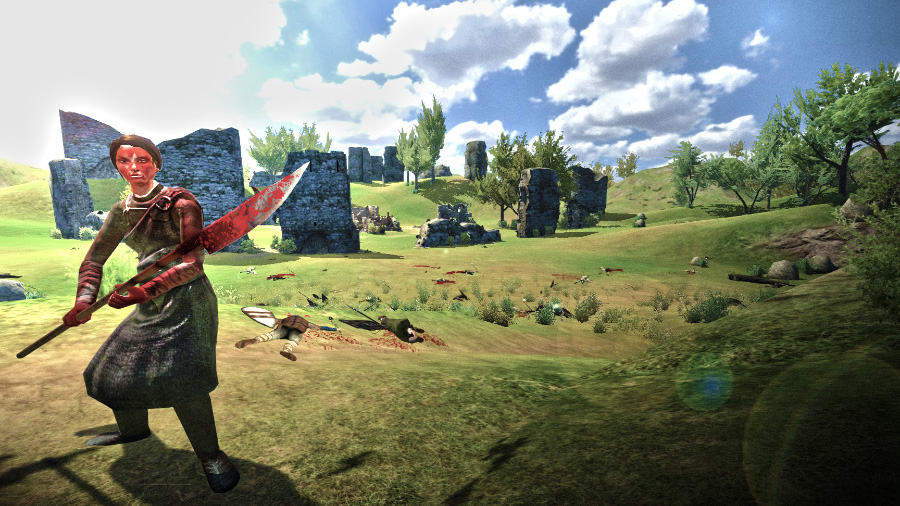
Credits goes to Muzzle for taking the time and effort to create all the videos seen in this guide and all members of the Cheshire Cats Clan (CCC) who volunteered as test dummies in them.


Credits goes to Muzzle for taking the time and effort to create all the videos seen in this guide and all members of the Cheshire Cats Clan (CCC) who volunteered as test dummies in them.











